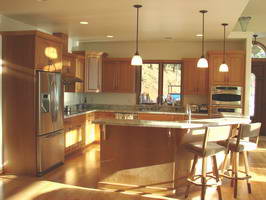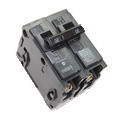GE Breaker Type Prevents Dryer From Working – Part 1
 '; ';
|
How to Fix a GE Breaker Problem: Dryer Circuit Requires Corrected 220 Volt Circuit, I recently attempted to install a new dryer using 240V – 4wire installation procedures. © By: Dave Rongey |
Dryer Circuit Requires Corrected 220 Volt Circuit
Electrical Question: I recently attempted to install a new GE DSXHS47 front load Dryer using 240V – 4wire installation procedures.
Although unit manual shows it is 3-wire single phase, I believe I am able to utilize the 4 wire installation as well and simply remove the white neutral grounding and replacing it with the cords 4-wire green ground wire, then rerouting the neutral white back onto itself.
The Problem with The Dryer
- Dryer works as I have both Red and Black hot leads at 120V each leg, and the Dryer spins, but am not receiving any “TEMPERATURE” lights off of the dryer and the dryer is not producing any heat period.
- The book’s troubleshooting indicates a blown leg of a breaker so I went ahead and replaced the already brand new 30-Amp Breaker with an all new 40-Amp breaker. I have put both the red and black leads in the breaker, placed the white neutral lead to the panel’s other white leads, but using a totally unused screw point. Then put the bare ground wire also on the panel into it’s own grounding screw point.
- The 4-wire plug has also been wired correctly I believe as I followed the installation procedures for black, red, white and ground to this receptacle, so I must have something wrong “I BELIEVE” within the neutral wiring of the dryer itself.
- I need to know where I went wrong. The drum spins, but no LED on the Dryer panel and no heat, but yet the multi meter shows 120V each red and black lead from panel to inside of Dryer.
- I get a 120V reading touching red meter lead to both red and black leads and black meter lead to ground point, however I get “nothing” when attempting to meter test touching red meter lead to both red and black leads and black meter lead to neutral.
This tells me I believe I have something not configured correctly within the neutral itself.
I believe I just need to know a bit more about neutral wiring as it relates to power sources?
Please review and advise!
Thanks,
Gary
This electrical wiring question came from: Gary a Homeowner from Calif.
Dave’s Reply:
Thanks for your electrical wiring question Gary.
How to Fix a GE Breaker Problem
240 Volt Dryer Circuit
- All electric dryers require a dedicated 30 amp, 240 volt circuit.
- When properly installed the receptacle at the dryer location will produce these readings
- 120 volts from each Line to Ground
- 240 volts Line to Line, consisting of the 2-pole circuit.
PRECAUTIONS
- Electrical circuit testing should be done with the cover installed.
- 240 volt circuits should be installed with a permit and inspected.
The Following will assist you with your Dryer Circuit
House Wiring Circuits and Circuit Breakers
This article looks at common 120 volt and 240 volt house wiring circuits and the circuit breakers that are installed identifying the types and amperage sizes used in most homes.
Circuit Breakers
Electrical Wiring Protection using Circuit Breakers
A guide to home electrical circuit breakers and how they work to protect your electrical wiring. When properly installed, your home electrical wiring is protected by a circuit protection device.
Wiring a Dryer
Wiring a Dryer
See an electric dryer installation with a typical 220 Volt electric power cord wiring system. You may find yourself with either a 3-wire or 4-wire electric dryer, or a 3-wire or 4-wire outlet. Lets look a how the electric dryer is wired and what to do if your cord does not match the plug.
Electrical Troubleshooting
Troubleshooting Electrical Wiring Problems
Licensed Electrician Reveals the Secrets of Successful Electrical Troubleshooting Methods used to solve the majority of the home electrical problems and wiring failures encountered.
The following may also be helpful for you:
|
|
Be Careful and Be Safe - Never Work on Energized Circuits!
Consult your Local Building Department about Permits and Inspections for all Electric Wiring Projects.
More articles about Electrical and Home Electrical Wiring: |
|
| « Previous | Next » |
Making Pigtails for Ground Wire Connections |
Nicked Electrical Outlet Wiring and Greasy Stuff |


















